


There’s more to a beautiful smile than meets the eye!
In our office, smile design is a process that blends science and art to create a beautiful smile that is uniquely yours. It is a collaborative effort involving the patient, the doctor and the laboratory technician.
What sets us apart from other offices that “make veneers” or “do implants” is that we combine cosmetic dentistry with facial aesthetics, incorporating a thorough understanding of how the teeth work to create smiles that are not only beautiful, but also comfortable – and will stand the test of time.
Teeth provide support for the lips and cheeks when we smile, and then, as the jaw moves, the teeth allow us to speak and chew. The knowledge that tooth form must follow tooth function influences and guides every smile we create, whether your restoration involves porcelain veneers, all ceramic crowns, complex restorative dentistry and rehabilitation, or dental implants.
Dr. Margolies will guide you through each step in the process, supported by his ceramist. Together, we will design your smile to ensure that it is everything you have always wanted.
Click on the links to the left to learn more about our services or contact us to set up an appointment.
The mouth is like a complex machine.
Many factors can cause it to break down: decay, gum disease, tooth loss, accidental trauma, or old dental restorations that have failed. An improper bite can make chewing difficult and produce painful jaw joints (TMJ) and headaches. As we get older, the teeth may simply wear down. Sometimes, a smile that nature has left unfinished just needs a little help.
Restorative dentistry requires a multidisciplinary approach that often incorporates facial aesthetics and restorative dentistry, periodontics, orthodontics, endodontics, oral surgery and/or dental implants, and must be supported by advanced dental laboratory technology.
Whatever the restorative problem, Dr. Margolies has the knowledge and experience to analyze and select the appropriate treatment, and the artistic skill to restore your mouth to health and beauty.Our NYC dental restorations are designed to stand the test of time.
Dr. Margolies has focused on solving complex dental problems for over 30 years, and has published articles and lectures to other doctors on his techniques.
We invite you to look through Dr. Margolies’s case examples – you may be surprised to find patients we’ve helped that are just like you. Then, click on Designing Your Smile – Complex Rehabilitation to see how we do a case, step by step.
Interested in other dental services? Learn more about dental implants and cosmetic dentistry.
The jaw joint is located just in front of each ear. It is a complex joint controlled by many muscles. Pain in the jaw joints can result from grinding, clenching, and/or an incorrect bite position. The jaw muscles can become overworked, fatigued, and go into spasm. Pain may be experienced in and around the joints themselves. Pain may also come in the form of earaches and headaches, as well as back, neck, and shoulder spasms. The pain is often persistent, and can become so severe that at times it may be debilitating.
We provide a comprehensive jaw joint evaluation. Sometimes an appliance is indicated to wear over the teeth that will allow the muscles to rest and reduce the symptoms. Various medications can also be prescribed to help reduce the pain. In other cases, an incorrect bite will require dental restorations. The establishment and maintenance of a comfortable, proper jaw position is the foundation of all of our treatment.
Comprehensive dentistry recognizes the interrelationship of the teeth, gums, and supporting bone and jaw muscles – the TMJ. All these structures must function together well to allow us to chew, speak, and smile for a lifetime!
If you are experiencing TMJ symptoms, don’t ignore them. You don’t have to try to cope with them on your own. We can provide both immediate relief and long-term treatment to resolve TMJ problems.
If you are looking to improve the appearance of your teeth and gums, then our cosmetic dentistry services may be for you. A consultation is the best way to decide what type of solution is best for your personal situation. We offer many types of cosmetic dentistry solutions. Please note that there is a separate page for types of dental implants that are often used in cosmetic dentistry.
We invite you to look through Dr. Margolies’s case examples. You may be surprised to find patients we’ve helped that are just like you. Then, click on Designing Your Smile – Cosmetic Dentistry to see how we do it, step by step.
Would you like a brighter, cleaner, more attractive smile? Veneers may be the answer.
A veneer is a thin shell of porcelain that is bonded to the tooth to improve its color and shape. It generally covers only the front and tip of a tooth. Veneers can be used to close spaces between teeth, lengthen small or misshapen teeth, or whiten stained or dark teeth. They can even be used with advanced techniques to correct an entire bite. When teeth are chipped or beginning to wear, veneers can protect them from damage and restore their original appearance.
It generally takes two appointments to restore teeth with veneers. During the first appointment, a very thin layer of enamel is removed from the front surface of the teeth to make room for the veneers. Impressions are taken which are used to make precise working models. Uniquely designed temporary veneers are placed over the prepared teeth in order to show you what your new smile will look like. In the laboratory, the ceramist carefully blends porcelain powders to create the veneers in specific shapes and colors to fit the models of the prepared teeth. At the second appointment, the new veneers are bonded to the teeth with an adhesive that is hardened by a high intensity light. Once in place, veneers virtually become part of the teeth.
We invite you to look through the case examples – you may be surprised to find patients we’ve helped that are just like you. Then, click on Cosmetic Dentistry – Porcelain Veneers to see how we do a case, step by step.
If you have any questions about NYC porcelain veneers, do not hesitate to contact us. Call (516) 593-2100.
Looking for other cosmetic dentistry options? See also our pages for:

We are an experienced provider of Invisalign® orthodontics. The program uses a series of clear, removable, comfortable, custom-made aligners to straighten your teeth.
Impressions of your teeth are digitized in order for us to work with a computerized 3-D image. Then, we digitally plan the movement of your teeth to their correct position. You’ll be able to see a virtual representation of your teeth before, during, and after completion of the Invisalign process. You will be able to see what your smile should look like at the end of the treatment process.
Because you remove your aligners before you eat and drink, there are no food restrictions or problems with brushing or flossing. The aligners are also more comfortable than conventional braces, as there is no metal or wire to cause abrasions in the mouth. You will change them about every two weeks, and your teeth will move – little by little – toward the smile you have always wanted.
We offer free Invisalign NYC consultations. Schedule an appointment for an Invisalign dentistry consultation to find out if it is right for you. Call .
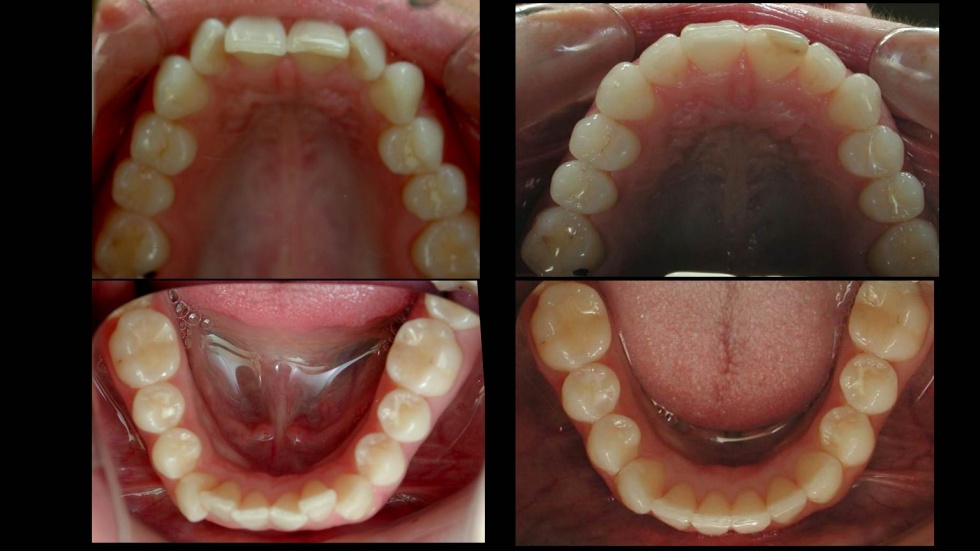
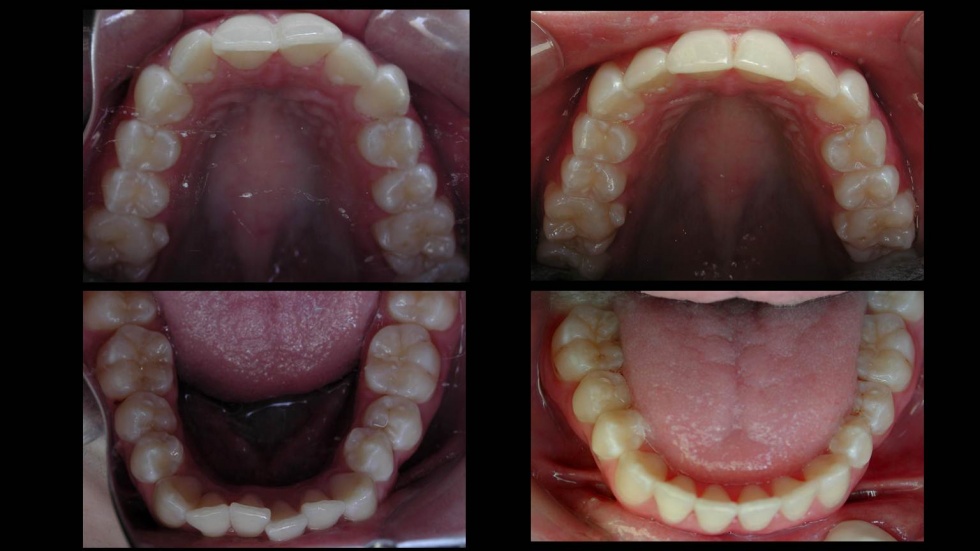

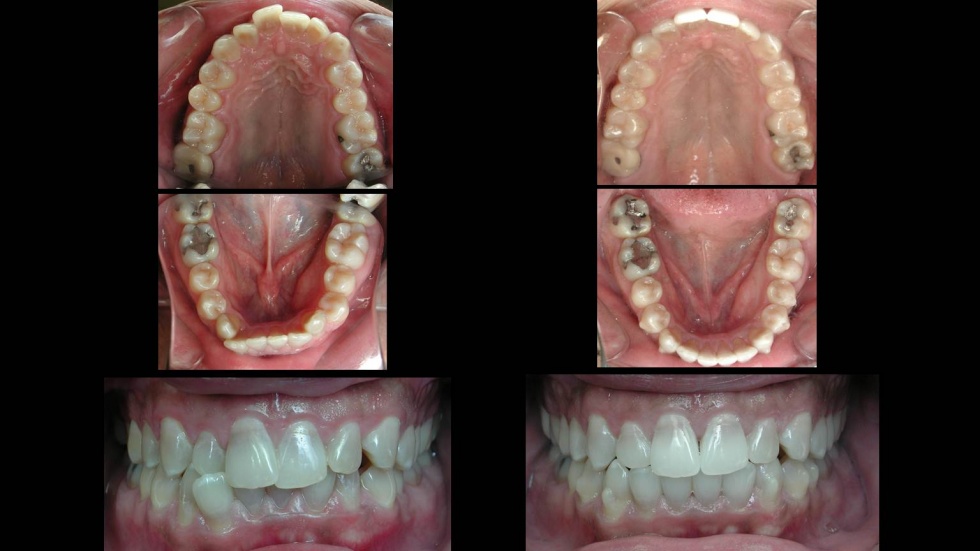
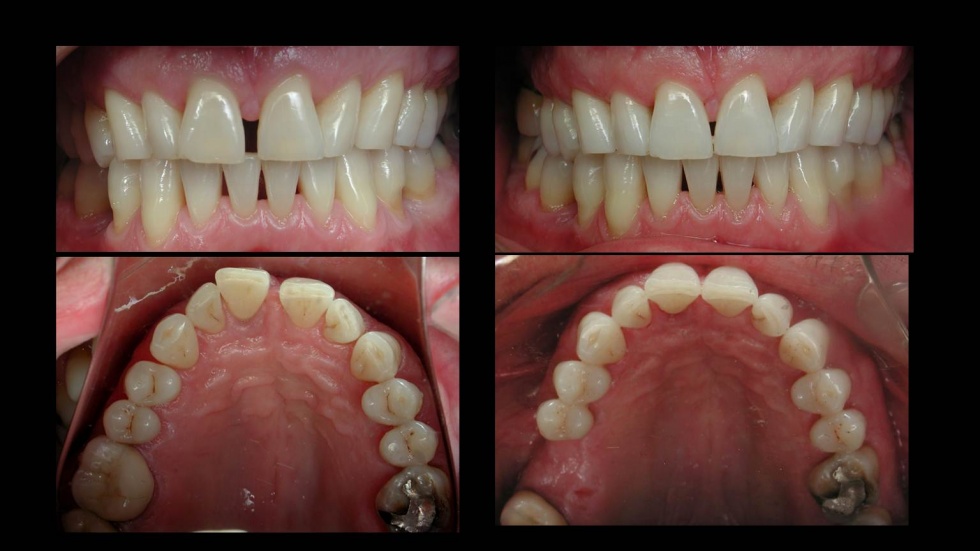
Looking for other cosmetic dentistry options? See also our pages for:

KöR Whitening was ranked as the most effective, reliable way to permanently whiten teeth, by a respected dental products journal. No other dental product of any type has ever been ranked higher. KöR is the only whitening system to ever receive a rating of “Best Product.”
We make molds of your teeth in order to fabricate your own unique, comfortable whitening trays.
Next, you will have a professional teeth whitening treatment in the office, followed by wearing your trays for two weeks at home while you sleep. The KöR Whitening Deep Bleaching System is completed with a final whitening treatment in the office.The KöR Whitening Deep Bleaching™ trays are different because of their precise fit. Unlike regular trays, these trays seal the whitening gel inside, enhancing its effectiveness by preventing it from leaking into your mouth.
The process is convenient. By wearing the trays only while you sleep, tooth whitening doesn’t interfere with your everyday life.
So, if you’re too embarrassed to smile, have dark-stained teeth, or just simply want a whiter smile, call us today for a no fee teeth whitening NYC consultation to see if you are a candidate for KöR Whitening.
New York Comprehensive Dentistry offers a variety of cosmetic dentistry services, including:
If you’ve lost most or all of your teeth, you may be a candidate for cosmetic dentures.
Missing teeth makes it difficult to chew and speak properly. When the teeth are lost, the muscles in the face are not properly supported, and sag and droop, causing deep facial lines. The jaws move closer together since there are no teeth present. Cosmetic dentures re-establish facial height and rejuvenate the face, reversing the signs of aging and restoring self-esteem.
Dr. Margolies customizes each aesthetic denture restoration to the individual patient. With cosmetic dentures, there is no settling for an uncomfortable fit or an artificial look commonly associated with conventional dentures. Following the same principles of aesthetics and function that are the basis of all of our restorations, Dr. Margolies creates a natural looking prosthesis, meticulously crafting beautiful teeth that are the proper size and shape for your unique smile, and that fit your mouth comfortably and securely. Visit Designing Your Smile to see how we combine Cosmetic Dentistry with the Art of Facial Aesthetics in all of our restorations.
Cosmetic dentures can also be supported by dental implants. For more information, visit our section on Implant Dentistry.



New York Comprehensive Dentistry offers a variety of cosmetic dentistry services, including:
One appointment inlays can save teeth.
Chipped, broken, or damaged teeth must be restored. Typically, treatment for these conditions involves crowns or partial crowns, requiring multiple visits. But now, Dr. Margolies can restore teeth in just one visit, using minimally invasive techniques that conserve as much healthy tooth structure as possible.
Dr. Margolies fabricates the inlay in our in-office laboratory while you wait, and then bonds it into place.
Because treatment with inlays strengthens the tooth, it helps avoid future emergency dentistry situations that could require crowns, root canals or extractions. The result both looks and feels beautiful and natural.
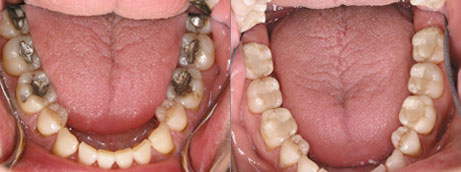
Learn about other cosmetic dentistry services, including:
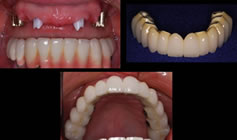
If you are missing one or more teeth, you may be a candidate for dental implants. A dental implant is a titanium cylinder that is placed in the jawbone as an artificial substitute for a natural tooth root.
The dental implant itself, however, is just one component of a complex restoration. Implant dentistry requires a team approach. Dr. Margolies, the restorative dentist, leads the team that includes the implant surgeon, the dental laboratory, and the patient to select the appropriate implant restoration for each situation. Dr. Margolies’s extensive background in oral aesthetics and full mouth rehabilitation, along with his use of the latest technology, including 3D CT (dental cone beam) scanning, digital implant planning, and computer-guided surgery ensures the creation of an implant restoration that is comfortable, beautiful, and long-lasting.
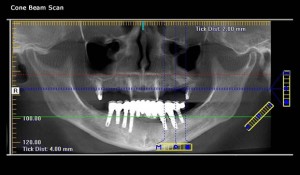
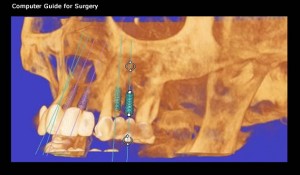
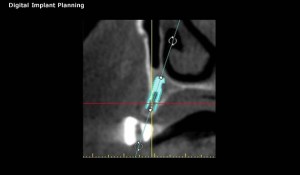
1. Who is a candidate for dental implants?
Anyone who is missing one or more teeth due to injury, disease, or decay may be a candidate for dental implants. Occasionally, older patients express the concern that their age may prevent them from enjoying the benefits that dental implants offer. However, health is more of a determining factor than age. If you’re healthy enough to have a tooth extracted, you’re probably healthy enough to receive dental implants. Dr. Margolies will determine if you are a candidate for dental implants after a careful evaluation of your dental and medical history. Consultations are complimentary.
2. What are the facial effects of tooth loss?
When teeth are lost, there are many facial consequences that occur. The teeth support the muscles in the face and contribute to our facial structure. When the teeth are lost, the muscles sag and droop, resulting in deep facial lines. The teeth help to maintain the appropriate distance between the upper and lower jaws. When the teeth are no longer present, the bone of the jaw shrinks, and the jaws collapse toward each other, resulting in a decreased facial height. As a consequence of this collapse, the chin protrudes too far forward. We also see a thinning of lips. Jowls form at the side of the face, where the muscles hang down due to lack of support. Patients who have worn dentures for a long time develop a “squashed” looking face. The loss of teeth speeds up the aging process dramatically.
When implants are placed, bone loss stops. The implants reinforce the bone, the same way steel beams strengthen a building. An implant restoration restores vertical facial height and returns support to the cheek muscles and lips, restoring muscle tone and vitality. Reversing an aging smile like this takes years off a patient’s appearance.
3. Is there pain or discomfort involved?
Most patients report that there is very little discomfort and that they were much more comfortable after the procedure than they anticipated. Implants are placed in a very gentle fashion and care is taken with the various tissues involved. Local anesthesia, and sometimes sedation, is used to eliminate any discomfort at the time of the procedure. An MD anesthesiologist is available when appropriate.
4. How will I benefit from dental implants?
The benefits of implant treatment include improved appearance, the enhanced ability to chew and enjoy food, and the protection of your remaining teeth and jawbone. Dental implants offer many options for the treatment of missing teeth. In short, dental implants look, feel, and function like your real teeth.
5. How long will the treatment take?
Treatment time will vary depending upon your unique situation. Today it is often possible to get well-functioning aesthetic-looking teeth the day of the surgery. In other cases, it may be necessary to wait several months before finishing the restoration in order to obtain an optimal result.
6. Will I ever be without teeth?
No! You will never be without teeth. In cases where the implants are not immediately used to support new teeth, a temporary restoration is always placed.
7. How long do implants last?
Dental bridges supported by implants have been shown to last over 15 years in 90% of cases. We have every indication that they will last for much longer. Most patients can expect them to last a lifetime. The first patient received his dental implants more than 40 years ago and they are still functioning today.
8. Is it important to take care of the implant after the procedure is completed?
Yes! Routine hygiene similar to regular tooth cleaning will help to assure long-term success of your treatment. You will be responsible for daily plaque removal, which can be accomplished through brushing and flossing around your restoration. We will show you how to properly care for your implants, and you must visit us several times a year for maintenance.
9. How long have implants been done?
Implants are not new to the dental field. Research was started in the 1950s. Professor Branemark placed his first osseointegrated implant in a patient in 1965, after many years of preclinical studies.
10. How much do implants cost?
The fee for tooth replacement with dental implants will depend on several factors, including the number of teeth being replaced and the number of implants required to support your replacement teeth. It is important for you to know that you do not need an implant for each missing tooth root, and some additional procedures may be required prior to the placement of your dental implants. After a thorough diagnostic evaluation, we will recommend the treatment that is best for you, and what your investment would be for the procedure. We offer a complimentary consultation. It will cost you nothing to find out. Please call to make an appointment.
Single Tooth Implant Restorations have replaced the traditional 3-unit bridge as the treatment of choice for single missing teeth.
With a 3-unit bridge, 2 healthy teeth on either side of the space have to be reduced in preparation for a set of 3 connected crowns to be placed over them, with the middle crown filling the missing tooth’s space. With a single implant, the adjacent teeth are not damaged.
Single tooth implants are now the preferred choice of treatment. We offer a variety of dental implant services, so make an appointment to learn what the best option is for you.




Beautiful new teeth in just one visit.
If you are embarrassed by your smile and your teeth are failing or causing you pain, the All-on-4® dental implant technique may be for you. In just one visit, the teeth can be removed, implants placed, and your new non-removable teeth attached. Because the implants in the back of the mouth are angled to avoid the sinus in the upper jaw, or nerves in the lower jaw, sinus lifts or bone grafts are not necessary.
Are you suffering with dentures? Or, have you been told you are not a candidate for traditional implants? Consider All-on-4®
Compared to traditional techniques, All-on-4® is faster, easier, with less complicated surgery, and has a shorter healing time - and as a result, may also be less expensive.
Faster, less complicated, more economical. Isn't that what you want? Call Dr. Margolies today for a no fee dental implant consultation or learn more about our other implant dentistry services.
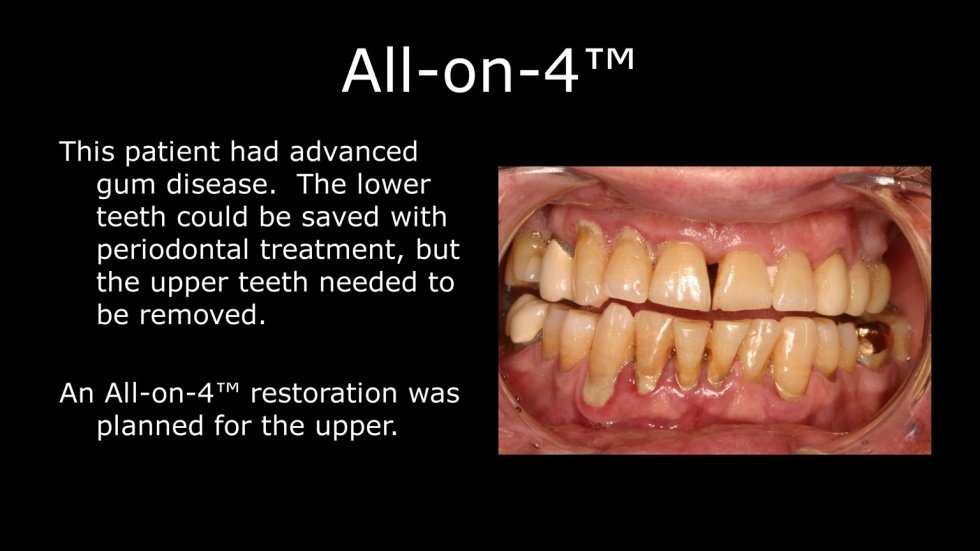
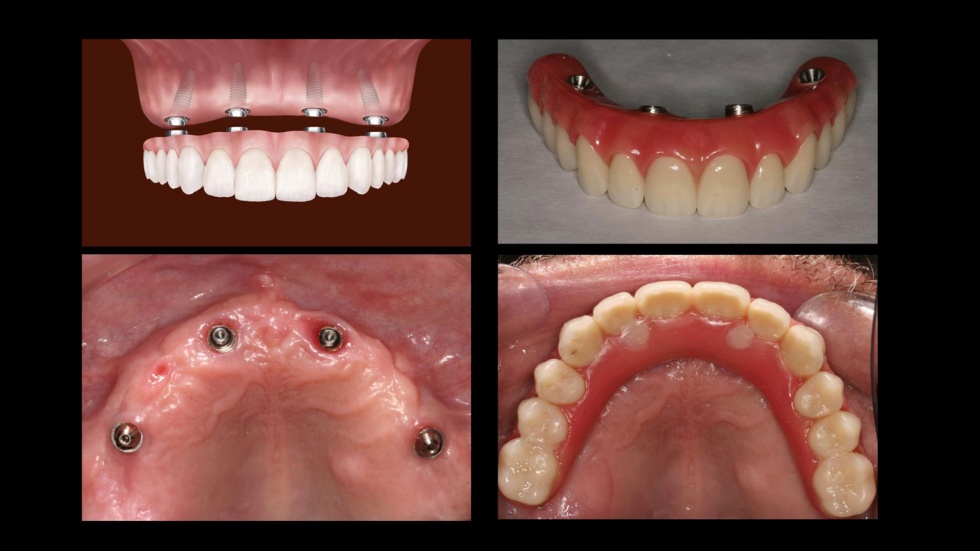
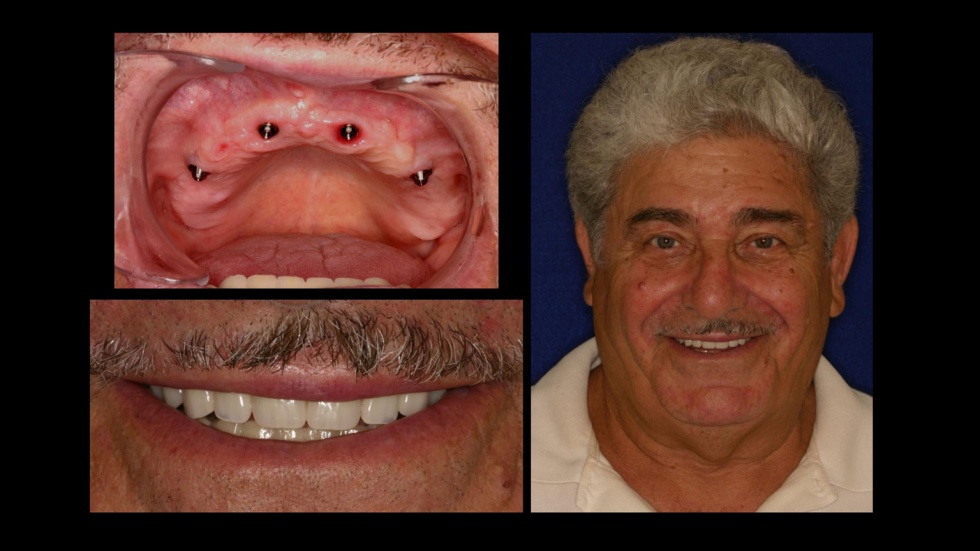
Digital Implant Bridge
Dr. Margolies also offers an innovative alternative to All-on-4™, the Digital Implant Bridge.
Failing teeth are removed and implants are placed immediately. The restoration is designed virtually and milled out of monolithic zirconia, a durable and beautiful all-ceramic material. The final Digital Implant Bridge is placed two days later.
Please call our office for a no-fee consultation to see if you are a candidate for this treatment.
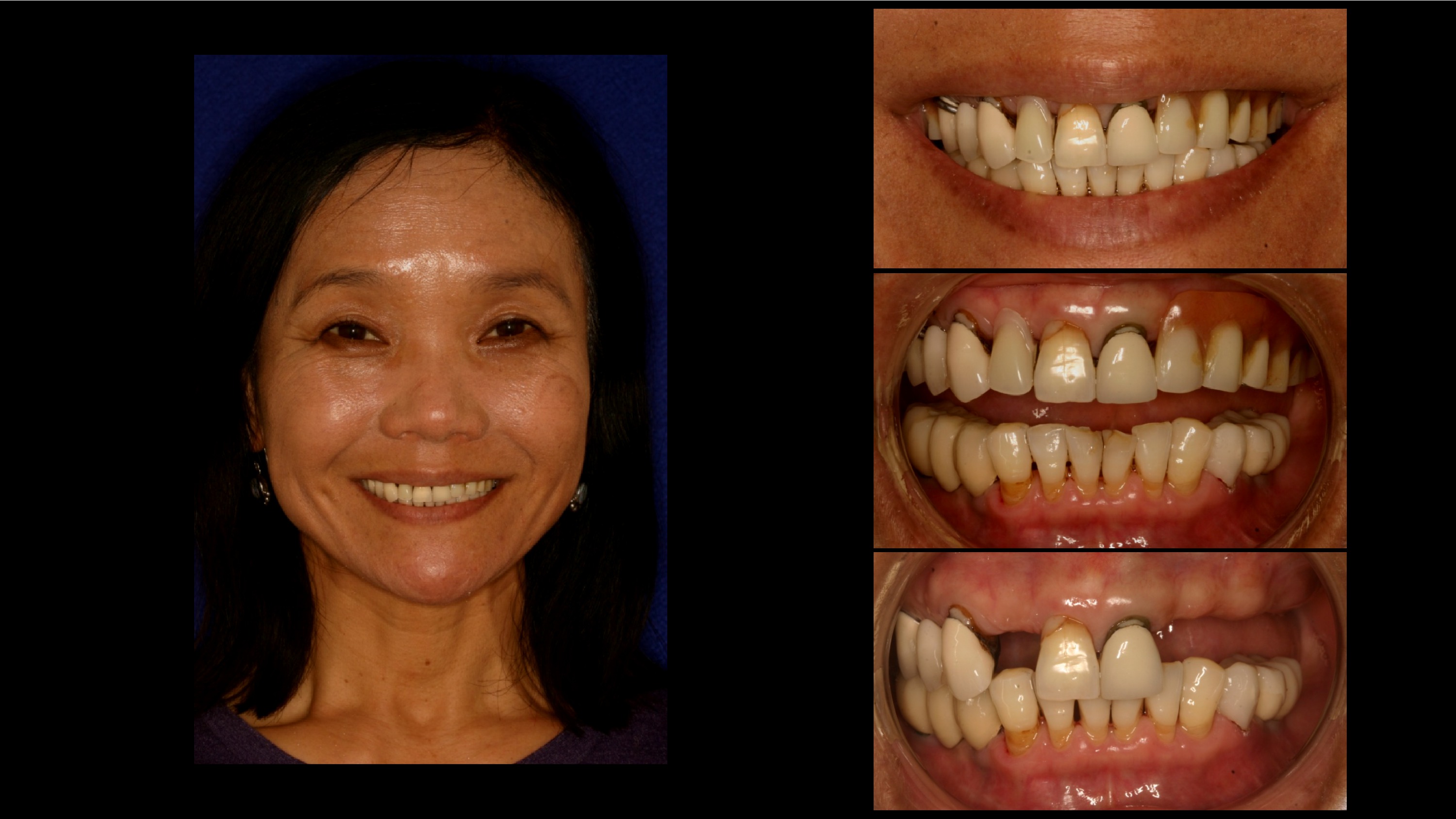

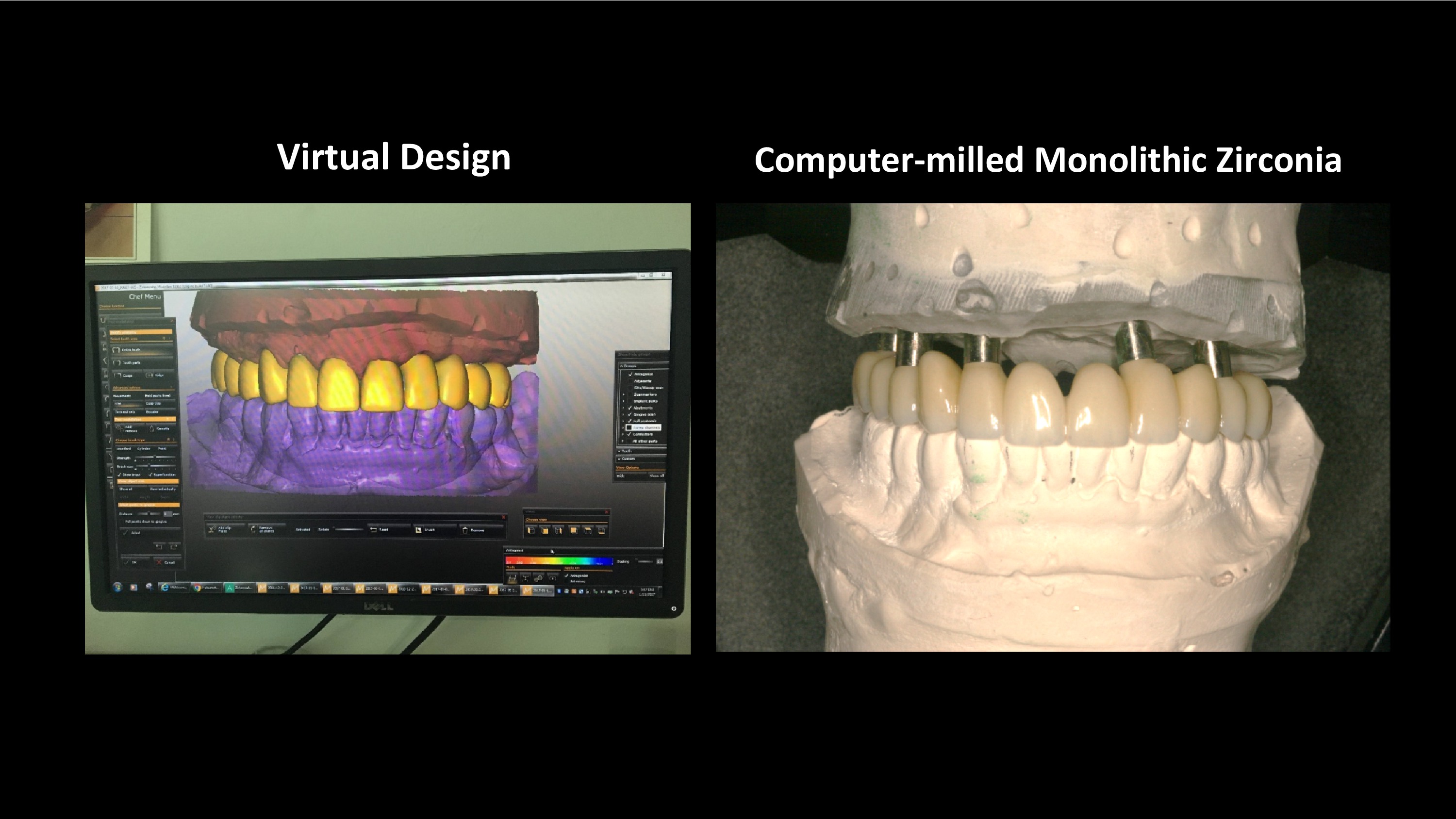
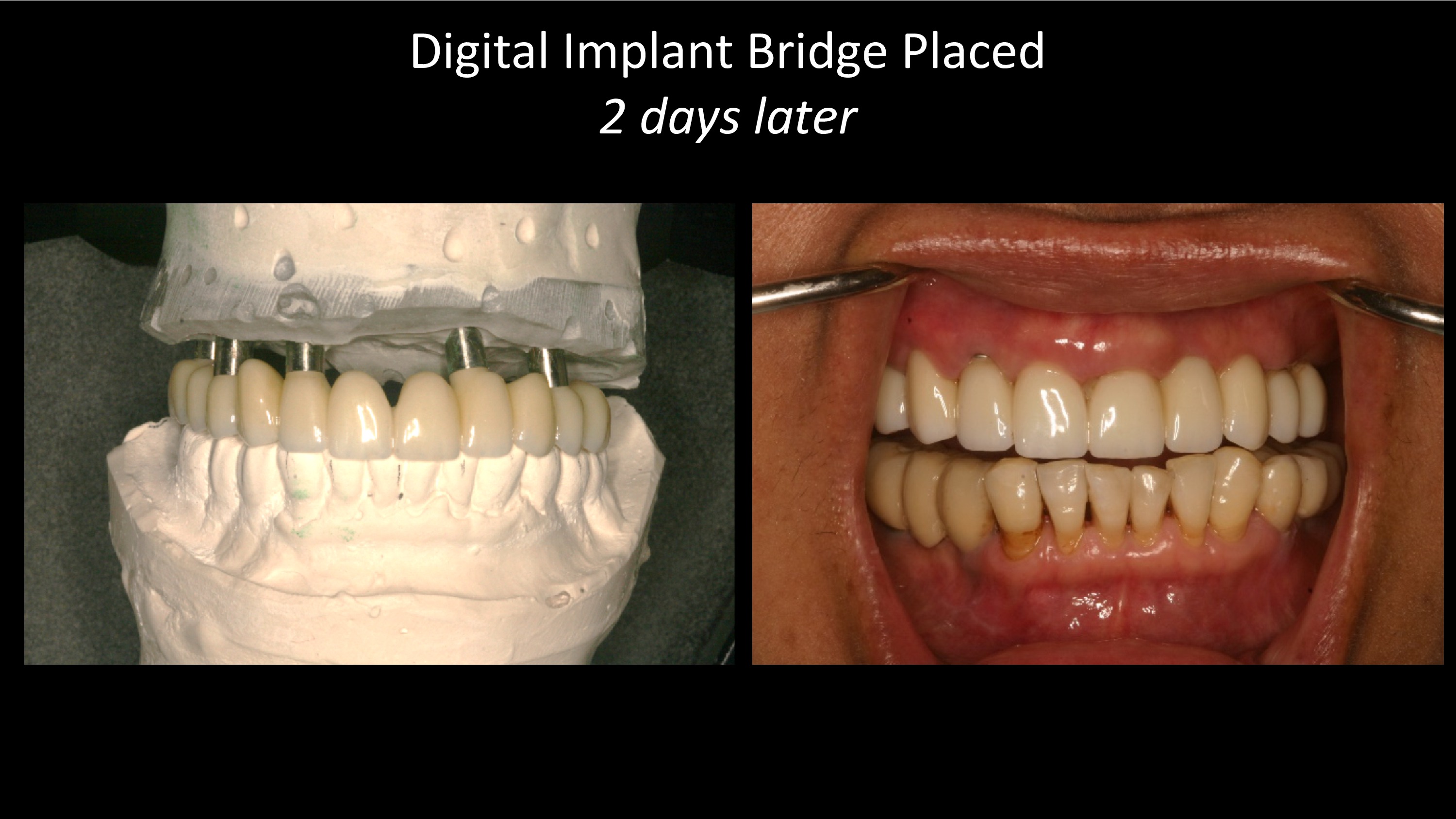
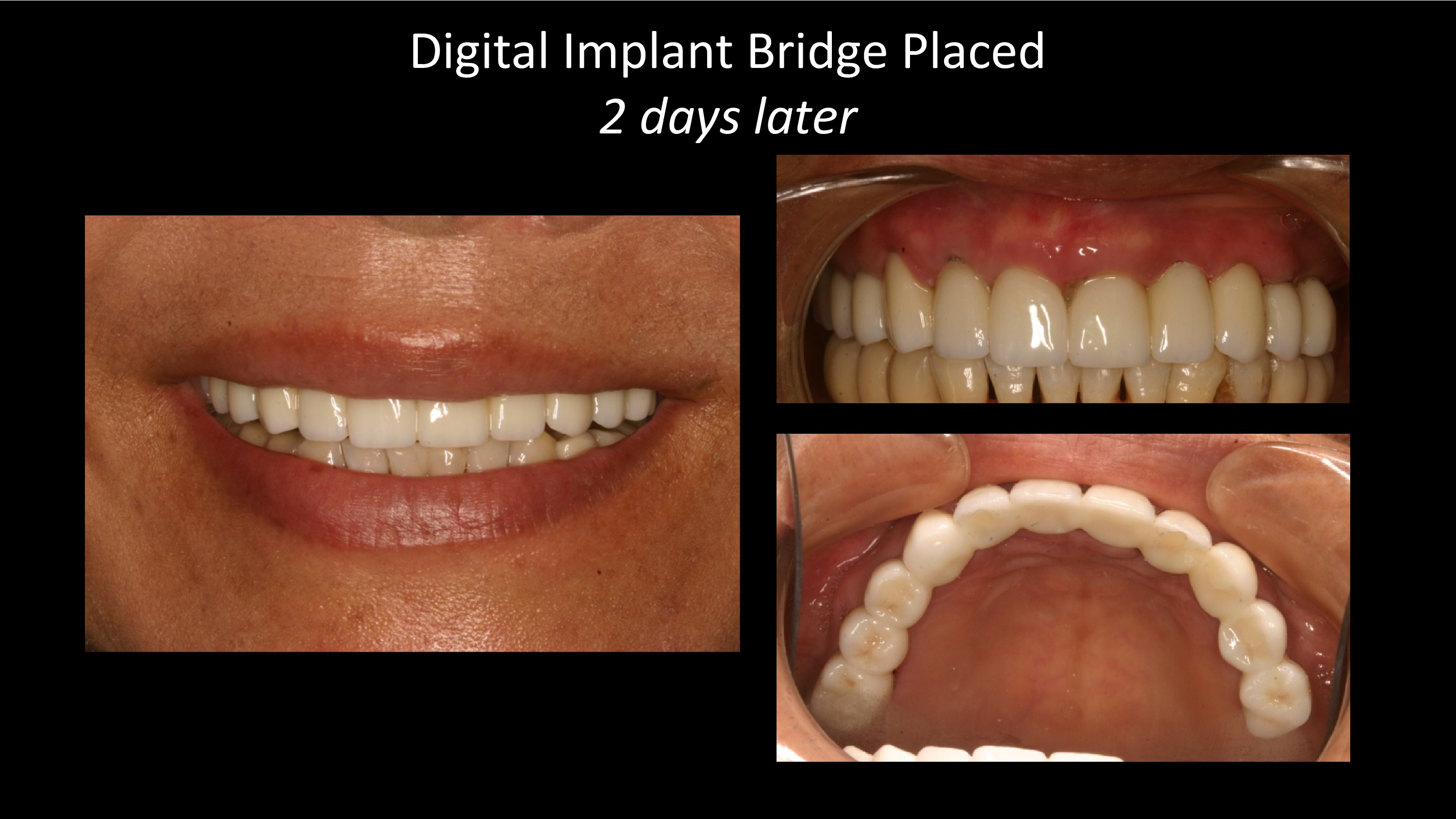
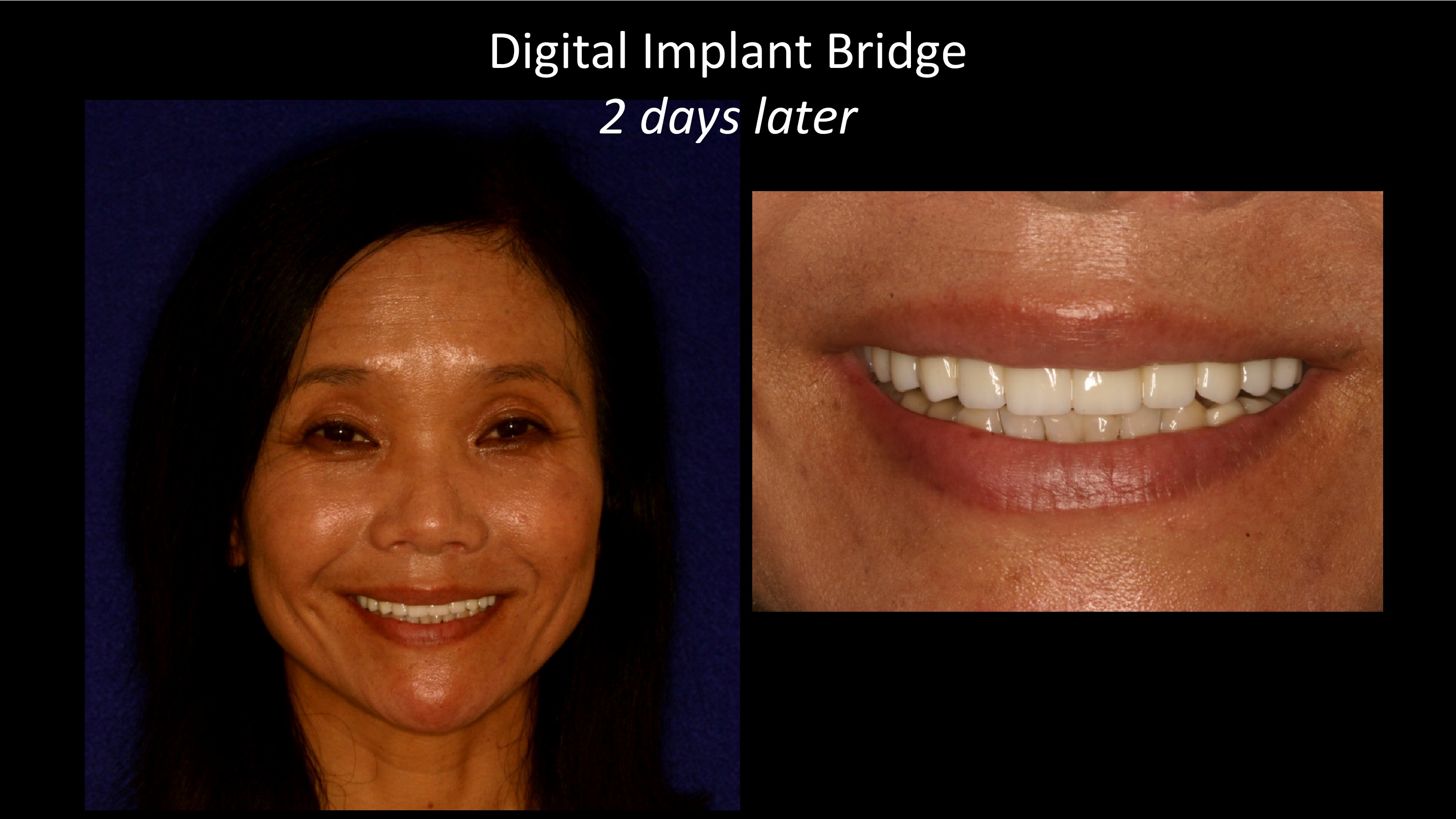





















What is Periodontal Disease?
Periodontal disease is an infection of the teeth, gums, and the bone that surrounds the teeth.
Nothing is more distracting, or destructive, to an otherwise healthy, beautiful smile than red, swollen, or bleeding gums. In fact, periodontal disease, not decay, is the major cause of tooth loss.
Nearly 3 out of 4 adults have some form of this disease in which bacteria attack the support for the teeth causing them to loosen. Unfortunately, most people who have periodontal disease are not aware of it because it's rarely painful, especially in early stages. Unless you have regular dental check-ups, including a periodontal exam, you may not be aware that you have a problem. Left untreated, periodontal disease will progress until your gums and bone have been seriously affected.
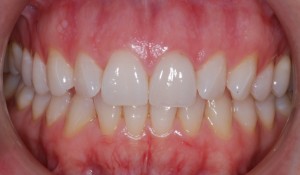
Healthy gums
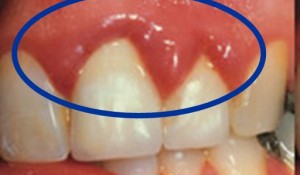
Periodontal disease
What causes Periodontal Disease?
The main cause is the accumulation of plaque. Plaque is the sticky film of food and bacteria that forms constantly on the teeth. Even if you brush and clean between your teeth frequently, you may not completely remove all the plaque, especially around the gum line. Each day, the plaque that isn't removed builds up and hardens into a rough, porous deposit called calculus, or tartar, which attaches to the surface of the tooth roots. The bacteria that cause periodontal disease grow in tartar. These bacteria produce toxins, and it's these toxins, combined with your body's response to them, that destroy the bone. Only a dentist or hygienist can remove tartar with a professional cleaning, because once it sticks to the tooth, there is no way to remove it at home. Neither a toothbrush nor floss will budge it.
What are the warning signs of Periodontal Disease?
Learn more about Periodontal Disease:
Since you may have periodontal disease without experiencing symptoms, we conduct a thorough visual examination of the gum tissue, take x-rays of the underlying bone, and do a thorough Periodontal Pocket Charting of each tooth.
The crevice between a tooth and the surrounding gum is called a sulcus. A healthy sulcus is two to three millimeters deep. When plaque and tartar invade a sulcus and it becomes deeper than three millimeters, it is called a pocket. Pockets are either an indication of gums that are swollen, or bone that has been lost.
We measure the depth of all pockets using a periodontal probe, a very narrow instrument that has markings like a ruler. The measurement is from the bottom of the pocket, where the gum is attached to the tooth, to the top of the gum margin. The depth of the pockets are now recorded in a chart and used to establish the current status of periodontal health. Future pocket chartings are used as a comparison to determine if changes are taking place. Pocket probing and periodontal charting are essential parts of a thorough periodontal examination, and are performed in our office on an annual basis, or more often when indicated.
We also examine the color, shape, and overall condition of the gums. Bleeding is a sign of infection. Healthy gums don't bleed! Healthy gums are firm and lightly stippled. In moderate cases of periodontal disease, we see swollen gums. In more advanced stages the gums become tougher or fibrotic. Swollen or bleeding gums are always a sign of disease, but as the disease progresses, the gums may not bleed, so don't be fooled.
X-rays also tell us a lot about periodontal disease, because they reveal the level of the bone. In a healthy mouth, the bone comes up high around the necks of the teeth, and the bone height is even throughout the mouth. With advanced periodontal disease, the bone levels are much lower, and are uneven.
In short, we look for the following signs to diagnose periodontal disease:
Learn more about Periodontal Disease:
Learn more about Periodontal Disease:
If you have periodontal disease, your choices are limited. Since in many cases, periodontal disease is not accompanied by pain, you might choose to delay treatment. However, this is very risky because periodontal disease never goes away on its own. It is episodic in nature, with flare-ups and periods of calm.
Periodontal disease is not curable, but new conservative treatments exist that are very effective. In contrast to classical periodontal treatment that often involves cutting away infected gum and bone, we provide a research-based approach for non-surgical gum therapy. If gum disease is detected, either at the first stage or when further breakdown has taken place, we employ non-surgical therapies to eliminate bleeding, reduce pocket depth, and regain gum support.
Non-surgical gum therapy is divided into 4 parts:
This technique is used to remove plaque and tartar below the gumline. First, to keep you comfortable, an anesthetic ointment is placed in the pockets. We use either a small scaling instrument or an ultrasonic scaler to carefully and meticulously remove plaque and tartar from the top of your teeth all the way down to the bottom of the pockets. Then, we will plane, or smooth, the root surfaces so the gums can heal and reattach to the teeth. Normally, we'll spread scaling and root planing over several appointments. The number of appointments varies with the depth of the pockets and the extent of the disease. This will maximize your comfort, allow us to check on the healing, and help you fine-tune your homecare efforts.
The second objective of non-surgical gum therapy is to reduce bacteria. Medications are placed in the pockets to control infection and promote healing. Antibiotics, like Arestin, may be used to further combat the infection. Once the source of infection has been removed, the gums will begin to heal, and will once again tighten around the teeth.
You will be given instructions on how to remove the plaque, as well as the instruments necessary to accomplish this, like an electric toothbrush and/or an oral irrigator. Appropriate toothpastes, rinses, or other medications will be prescribed, and the homecare regimen will be explained. Effective homecare is an important part of non-surgical therapy.
The health of your gums must be monitored closely so that we can prevent recurrence.
Periodontal disease can never be cured; it can only be controlled.
Following initial office therapy, you will come to see us every 3 months for ongoing care, which may include x-rays, re-evaluation of your periodontal health and the effectiveness of your homecare, removal of plaque above and below the gumline, and re-treatment with scaling and root planing if necessary. These frequent check-ups are vital for controlling your periodontal disease.
Periodontal disease is site-specific. This means you may experience a flare-up of the infection in just one periodontal pocket out of the possible total of 192 that exist in your mouth. Bone and tissue loss may occur in only this isolated area, or may be more widespread. If we aren't checking regularly for this type of damage to your gums and bone, you might not notice that it's occurring, and the destruction would continue unchecked.
Some bacteria do remain after treatment and may settle back into the pocket. Within ninety days the bacteria can again reach destructive levels. Because of the episodic nature of periodontal disease, and the fact that the disease process can re-establish itself so quickly, the typical 6-month re-care appointment just isn't enough. Statistics confirm that re-evaluation at intervals of at least every 3 months is critical for periodontal patients. This allows us to break the cycle of bacterial invasion, and minimizes the recurrence of the infection and its destructive effects on the teeth and gums.
For those patients with advanced disease, more aggressive treatment may be indicated. When necessary, we consult with several accomplished periodontal specialists and are happy to work with them on these types of cases.
Learn more about Periodontal Disease:
Patients who have pockets 4mm or greater that bleed on probing can be treated conservatively with Arestin. Arestin is a locally administered antibiotic containing minocycline, a tetracycline derivative. After scaling and root planing, Arestin, a powder that binds to tissue and fluid, is placed in the pocket. It remains in the pocket for up to 28 days and is absorbed by the body. Arestin reduces bacterial infection and stops it from causing further damage.
Patients treated with Arestin should:
(available for purchase in our office)
Learn more about Periodontal Disease: